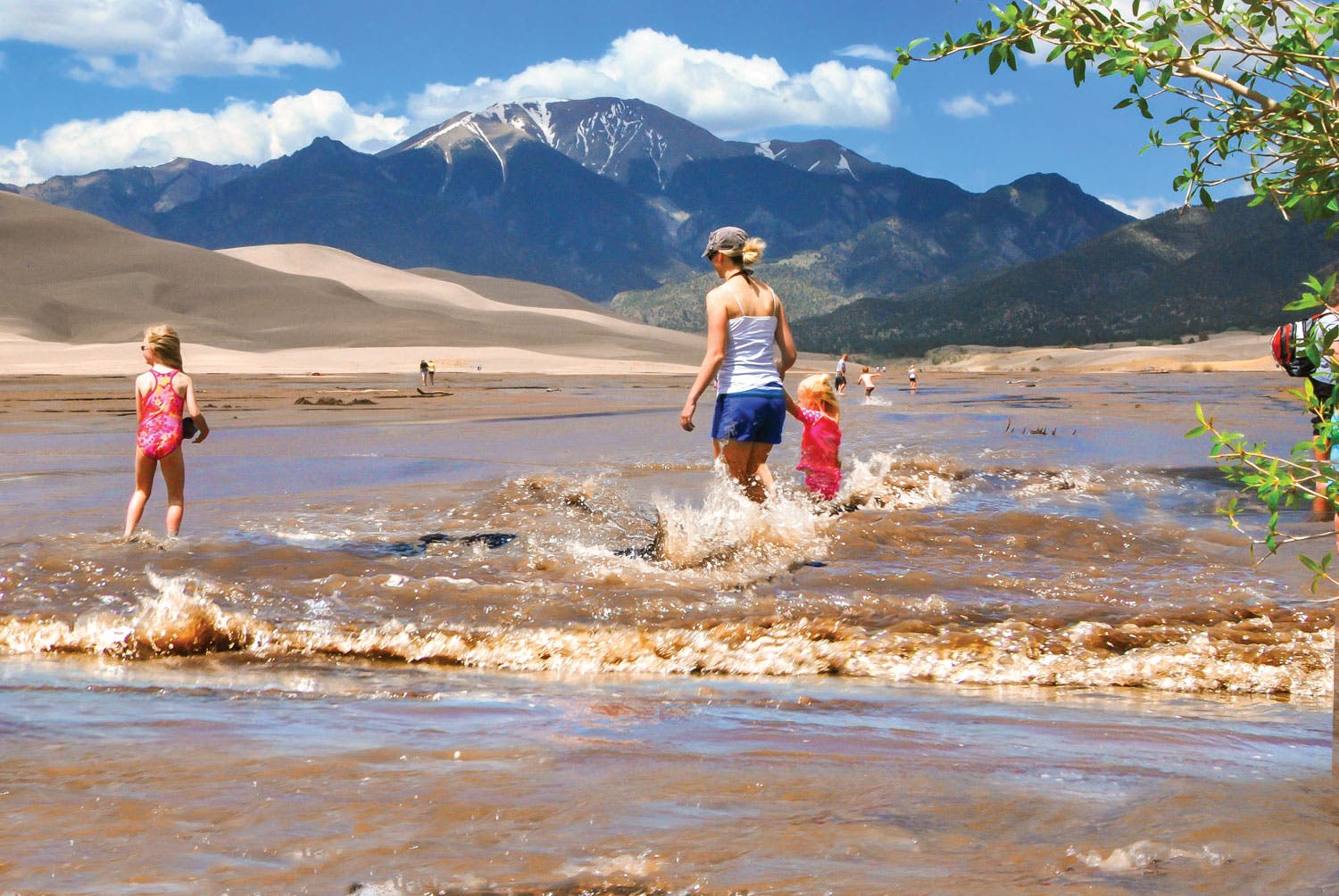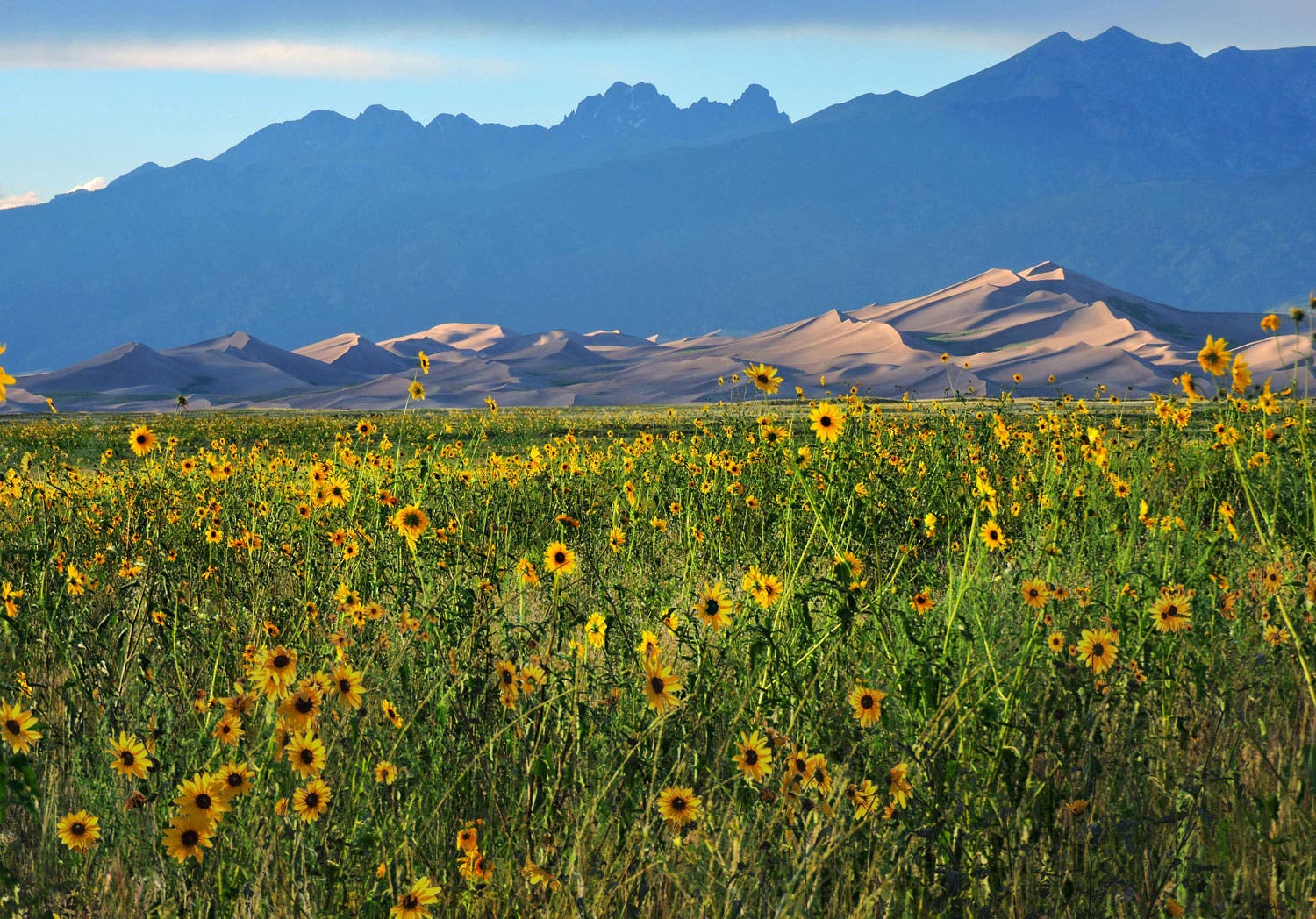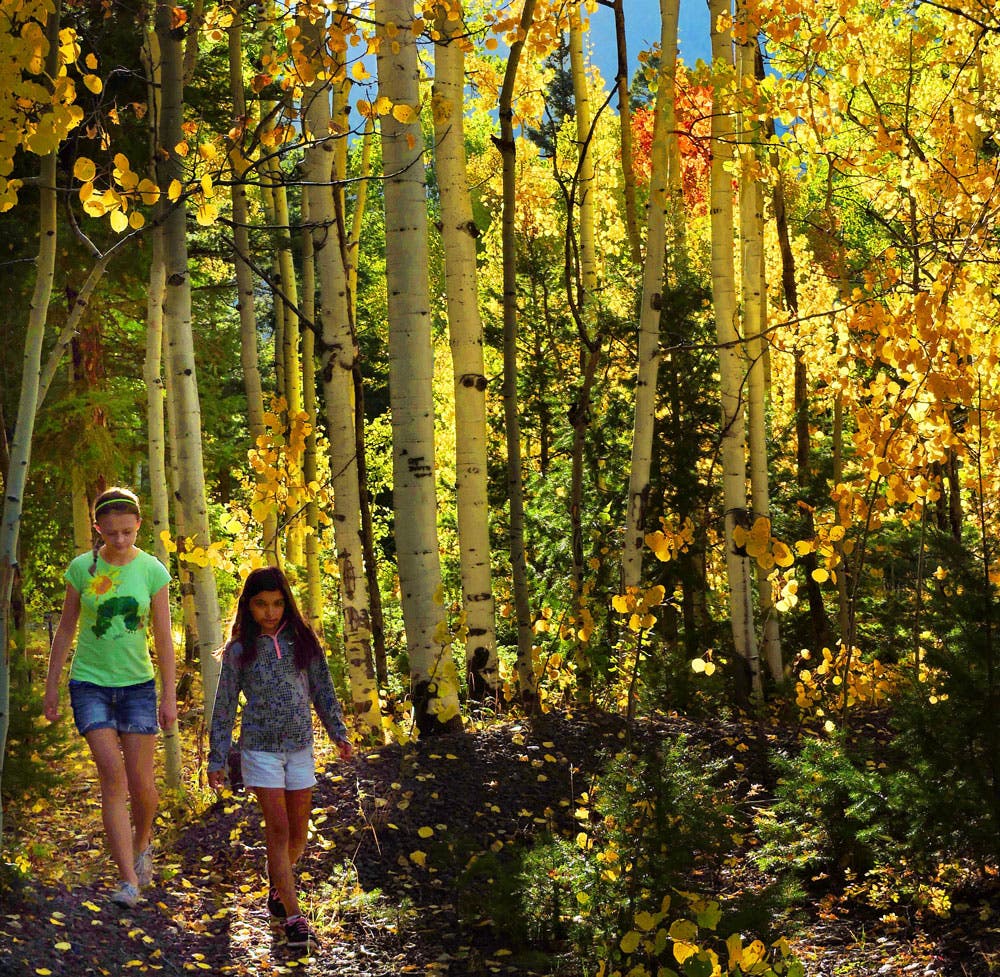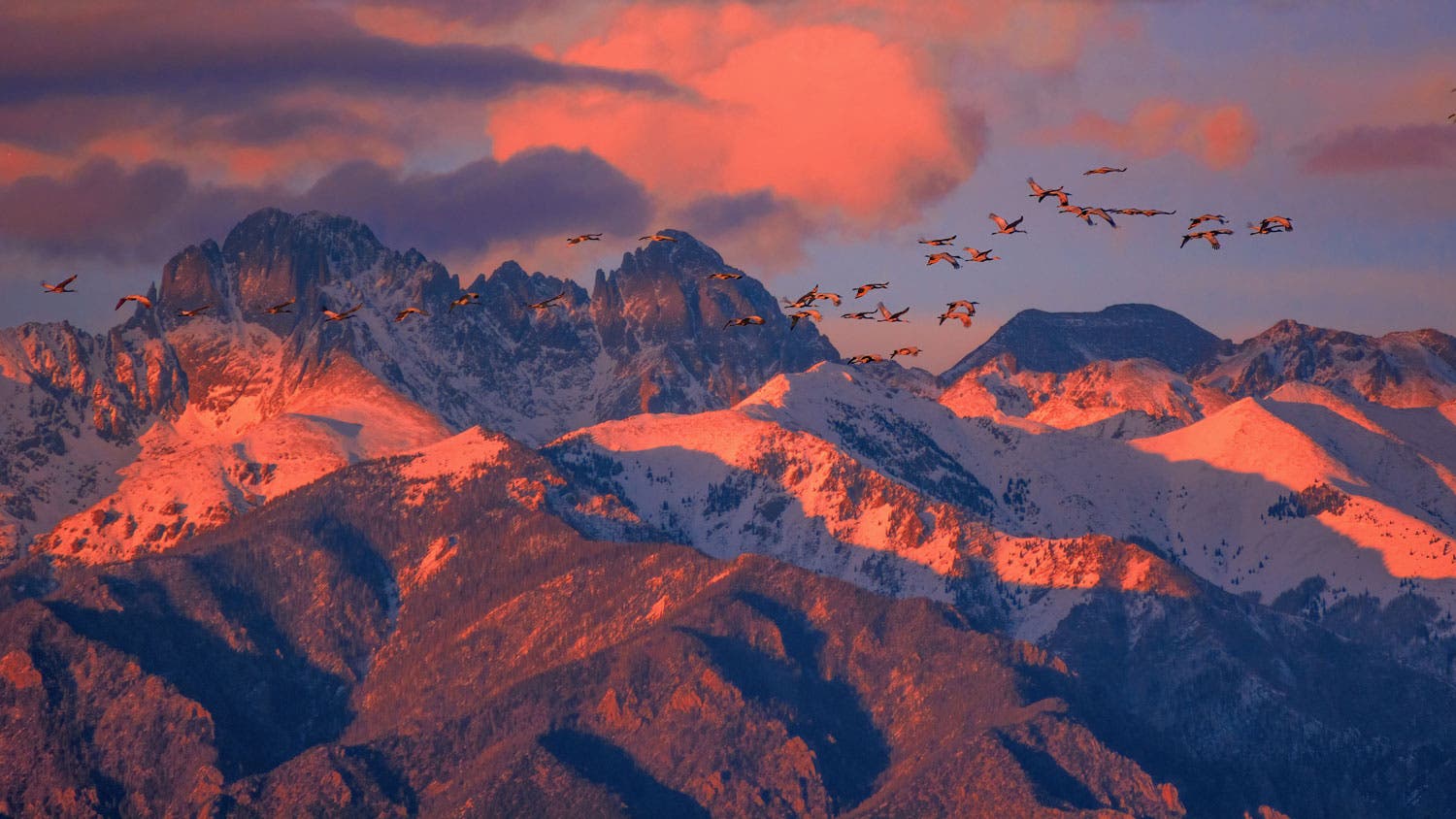What’s the Best Season to Visit Great Sand Dunes National Park?

Golden aspen over sand dune peaks taken October 3, 2017. (Photo: NPS/Patrick Myers)
Home to the tallest dunes in North America, Great Sand Dunes National Park treats visitors to sweeping vistas and a varied ecosystem that changes dramatically throughout the year. While there’s something to see in every season, the remote, high-altitude location of the park in the San Luis Valley does present some challenges. Even within a given season, conditions and temperatures vary widely depending on where you are in the park, as the elevation ranges from around 8,200 feet at the visitor center and campground all the way up to 10,000 feet along Medano Pass Primitive Road. Fall is the best time to visit if you don’t feel like dealing with the notoriously unpredictable Colorado weather and summer crowds. Skip a winter visit unless you love cold, windy conditions.
Here’s everything you need to know about visiting Great Sand Dunes National Park in all four seasons.
Spring (April – May)

Spring season in Great Sand Dunes National Park brings warmer weather, lots of wind and the return of Medano Creek, a seasonal stream that runs along the base of the dunes. April temperatures can still swing wildly, with highs in the mid-50s and lows dropping back into the 20s. Don’t plan on hiking to the higher elevations as many of the trails that head into the mountains as well as the majority of Medano Pass Primitive Road will still be under deep snow.
In fact, April is usually the second snowiest month in the park, though the fresh flakes typically melt off at the lower elevations within a day or two. Checking the forecast before your visit will be crucial since the weather can be volatile—one day could be warm, sunny and mild with the next delivering dreary, overcast and cold conditions. Springtime in the San Luis Valley is notorious for strong winds, and Great Sand Dunes National Park often sees the worst of these gales. The dunefield, which is constantly being shaped by these strong breezes, was originally formed by sediment and sand blown from the valley into the bend in the Sangre de Cristo Mountains, where opposing storm winds off the peaks helped form the sand into tall dunes. Plan to hike the dunes early in the morning to avoid blustery conditions and blowing sand which can make for a decidedly unpleasant experience.
May generally sees warmer conditions with highs holding steady in the 60s to 70s. Medano Creek, which starts flowing in April, typically sees its peak annual flow during May, thanks to the seasonal snowmelt. While the water can still be chilly, this is often the best time to grab a tube and go for a float. Most of the roads in the park are cleared, and Piñon Flats Campground, which opens around the end of April, will be available to reserve for overnight stays on Recreation.gov. By May, the conditions on the dunes can be quite hot in the afternoon (and still windy), so again, an early start is best if you’re looking to bag High Dune, Star Dune or just spend some time out on the sand exploring.
Summer (June – August)

June, July and August are the busiest months in the park, with visitation peaking in June and July and tapering off slightly in August. Daytime high temperatures range between 75 and 80° F, though keep in mind that on the dunes themselves, surface temps can spike to 150° F on sunny summer afternoons. Wear closed-toed shoes and keep dogs off the sand this time of day to avoid blistering sensitive feet and paws. Daytime temps at the higher elevations can be cooler by 5-10° F so don’t forget an extra layer. Thanks to the campground’s location at 8,200 feet above sea level, nighttime temps still drop significantly, often into the 40s, so if you’re camping be sure to pack warm layers and an extra blanket.
Summer is the best season in Great Sand Dunes National Park for camping, high-elevation hiking or off-roading adventures, though you shouldn’t expect to have the park to yourself. Medano Creek often flows through early June, before tailing off in July. As the water levels retreat, be ready for an influx of mosquitoes—bug spray is a must. If you’re interested in exploring the higher elevations of the park, on foot or by vehicle, the trails will be clear of snow and Medano Pass Primitive Road, a challenging four-wheel-drive route that is recommended only if you have a high clearance vehicle and some off-road experience, is also open.
In addition to leaves on the trees and more greenery around the dunes, summertime is when the wildflowers bloom—the prairie sunflowers on the dunes are a spectacular sight in August. During the summer season, afternoon thunderstorms often roll through the area so getting out early is recommended. You don’t want to be caught unprotected on the sand when lightning starts striking. Keep in mind if you’re planning an overnight trip that Piñon Flat Campground does require reservations which can be booked up to six months in advance on Recreation.gov and often fills up during the popular summer months.
Fall (September – October)

Autumn is the best time to visit Great Sand Dunes National Park if you’re seeking bluebird days and fewer crowds on the trails and at the campground. Daytime highs at the lower elevations average in the 60s to 70s, with chilly nights dropping into the 20s and 30s. And while you may still get an early-season snowstorm at the higher elevations where daytime temps sometimes drop into the 50s, generally, the afternoon thunderstorms will be replaced with sunny skies and mild weather, great conditions for a hike to do some leaf peeping.
Surface temperatures on the dunes can still be hot in the afternoons in September, so you may want to opt to get out on the park’s other trails—Mosca Pass Trail is a great hike to see some golden aspen groves this time of year. Along with the fall colors, this is also one of the best times of year to spot wildlife in the park. Medano Pass Primitive Road is still passable during these months, offering a great way to see more of the Sangre de Cristo Mountains.
October is the last month you can book a site at Piñon Flats Campground before it closes for the year. Fall is a great time for stargazing or astrophotography, as the Milky Way is visible high in the sky before midnight. If you’re looking to get into the backcountry for an overnight trip, fall is the best time to go backpacking. The park offers seven designated sites along the Sand Ramp Trail, where you can enjoy views of the dunes from the shaded forests along the base of the imposing peaks. For a more unique backpacking experience, hike to one of the 20 non-designated sites in the dunes backcountry which gives you a chance to pitch your tent on the sand. Don’t forget to get an online backpacking permit, available at Recreation.gov, before heading out.
Winter (November – March)

Winter in the San Luis Valley descends with a vengeance—while the high-altitude desert valley doesn’t see a ton of snow compared to other regions of Colorado, sub-zero temperatures are common through much of the winter. This is the toughest time of year to visit Great Sand Dunes National Park and, unsurprisingly, the least popular season due to the harsh conditions. If you’re planning to visit, be prepared for cold, windy weather.
Average highs are in the teens to 30s and lows can dip well below zero, with -5 to -15° F commonly seen during the coldest parts of winter. Snowstorms and blizzard conditions, though not regular, do occur, so always check the forecast at www.nps.gov/grsa/planyourvisit/weather.htm before visiting the park. Medano Pass Primitive Road closes in November and remains impassable through the winter season. Piñon Flats Campground is closed as well.
Though you should come prepared for cold conditions, the park does have a number of sunny, blue-sky days in winter. Visiting during this time of year gives you the chance to see the snow-covered dunes and presents the opportunity to go sledding or cross-country skiing. Wildlife, including elk and pronghorn, are commonly spotted in the area as the number of human visitors decreases. And in February, the annual migration of the sandhill cranes brings birders flocking to the region.